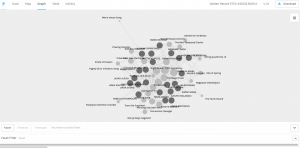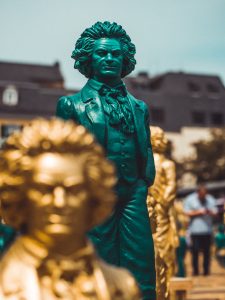
ETEC 540 Golden Record curation in .js0n file
Wow! This is only some of the data!
. . .but what does it really mean?

ETEC 540 Golden Record Curation in Palladio (whole group.
The network map created by the Golden Record Curation Quiz Data visually overwhelms at first glance. How can the careful selection of tracks can possibly be reflected in this web?
Examining the data for the whole class by selecting size nodes reveals that the men’s song was not a popular choice for inclusion. But why? My own reason for exclusion is that I found it repetitious and similar to instrumentation of other selections. Something had to go (no it wasn’t based on gender). So why the exclusion? Time for a closer examination.

Group 2
Group 2: In this smaller group of 5 curators, I noticed I was the only one to select the song from Japan, shakuhachi, “Tsuru No Sugomori” (“Crane’s Nest,”). I wondered if it was because they had already selected wind instrument music, similiar to my earlier exclusion of the Men’s Song, but the “why” is not evident reading this map. Three of us chose Beethoveen’s 5th Symphony but was it for its power or our familiarity? Only two in this group chose Dark Was the Night, perhaps not their style of music? Looking at the most included songs: Beethoven’s 5th, El Cascabel and Night Chant there is no way to know why these songs have been so often selected. I wonder about the choices of others. And turned to more qualitative data – blogs and discussion.
In reading classmates’ blogs’, and discussions, I discovered music was selected for very different reasons from mine, some of which I had never considered such. I selected Jamie Aston”s and my curations to explore further. For example,I chose Beethoven’s 5th Symphony and Blind Willie Jackson’s Dark Was the Night the same tracks as Jamie Ashton, but for very different reasons. Jamie’s categories for selection included “Differently- Abled” artists(deaf and blind) while for me, Jackson’s music was not only emotion filled but also represented the roots of rock and roll and Beethoven’s for the range of tones, pitches, volumes and the emotions.

Another category for inclusion or exclusion that Jamie used but I did not use was gender or tools of musical creation. Yet, despite these different selecting categories our selections did overlap on 50% of the selections. One commonality of category we did have was a desire for global diversity – but only chose two songs the same (I will let the reader try to figure out which two – it may surprise you). There is no way to know for certain.



And so . . .another closer inspection of curation comparisons was done with curators Sasha Passaglia and Margaret [Meg] Nash and myself. (Full credit goes to Meg for this comparison idea). After spending a week in an online class, working together on a project, we found we developed similar storylines without prior knowledge. and had similar ideas and philosophies. Our Twine project’s separate developed threads were easy to intertwine with similar scenarios and ending scenes. How would our curation compare? Very dissimilar. The only song all three of us curated was Night Chant but not for all the same reason (inclusion of indigenous representation or because of a memory).

Meg, Sasha, & Rebecca
But what does it all mean?

Many classmates chose to curate on the basis of culture, diversity or simple geography. Still others chose based on preference of genre or on the basis of evolution of music. Familiarity or their preference in music sometimes played a role in curation. But all of this was discovered by reading their blogs. Because I do know my own thought processes and reasonings, I chose to include myself in the exploration. Although, I can justify my musical choices in the curation task, exclusions and inclusions, the reason that I excluded pieces is not evident in the web. Did I exclude a piece because I disliked opera or was it because there were too many other similar pieces or was it because I wished to exclude human voices? You will have to guess (or read the early blog with my reasoning- and trust I have been truthful).
In answer to the question “Can the reasons for these “null” choices ever be reflected/interpreted in the data?” The simple answer is no. The Palladio tool “ . . . externalize[s] what is very internal, individual, thought process” (Stanford). The Golden Record Curation Task Quiz made a visual map of final decisions but not the reasoning. One can hypothesize on the reasons for choices but no concluding proof can be derived only from the network created in Palladio as it shows only relationship between final choices but not reasoning. What the data did was create a curiosity for the reasoning of others and the desire to seek out that reasoning driving further inquiry – my reason to examine some blogs
“What is missing from the diagram is the experience of using the tool. Palladio is tool for reflective practice. It is an environment that supports thinking through data” (Stanford). Quantitative data must be examined alongside qualitative. There is no way to realize the motive of choice, what aspect whether religious, cultural or political beliefs or experiences that drive an individual to make the choices they do. We need to be very careful about making assumptions and decisions based on data presented – interpretation and further investigation is necessary to understand the connections. And we need to remember that the original 27 songs were embedded in the culture, norms and values of the Euro-western curators of 1977 (and in some cases even what was available due to copyright laws.) We have embedded our own values and biases in this task. Do we let bias based decisions drive society or do we explore those biases?
Songs that did not even make the Golden Record 27:
Can songs and song choices have political agenda’s embedded? Absolutely, and especially by virtue of being excluded. I can only speak from a Canadian of mixed ancestry (exposed to US media) and as a youth in the 70s. Consider why the following songs were not added to the play list:
Another song from 1964 that could have been included: Simon & Funkel Sound of Silence
Or better yet the updated version more contemporary Sounds of Silence by Disturbed: https://youtu.be/u9Dg-g7t2l4
Can you “read my message?” Do I have a political comment or message embedded? Now I challenge you to create your own list of excluded songs.
References:
Stanford Humanities and Design. http://hdlab.stanford.edu/palladio/about/